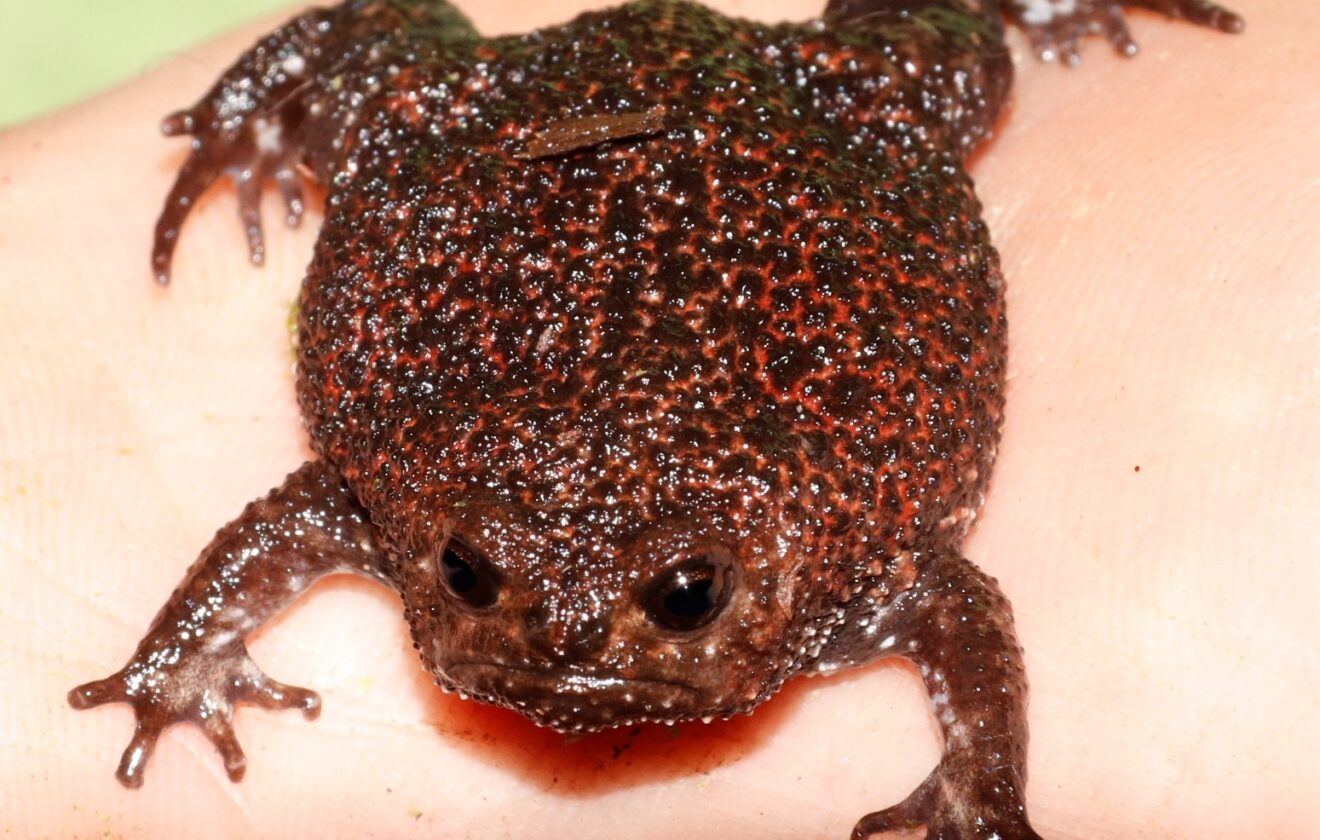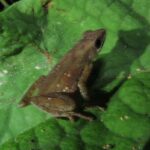As dawn breaks softly over the misty montane forests of South Africa, the subtle rustlings beneath the leaf litter hint at a hidden world. Here, among damp, decomposing vegetation and rich, loamy soil, lives a creature so elusive and intriguing, it’s easily overlooked—unless, of course, you’re listening closely. Meet Breviceps acutirostris, affectionately known as the Strawberry Rain Frog, a curious amphibian cloaked in mystery, possessing habits that charm even the most cautious observers.
What stories might one discover by delving into the secretive world of Breviceps acutirostris? How does its distinctive appearance play a critical role in its survival, and why should the broader world care deeply about its conservation? Journey with us as we peel back the hidden layers of forest soil and explore the fascinating narrative of this enchanting frog, from its earthy shelters to its ecological significance.
Taxonomy and Classification#
Breviceps acutirostris belongs to a unique subset of anurans within the family Brevicipitidae. Members of this distinctive family are not only defined by their particular shape—an almost spherical body—but also by their unique reproductive behaviors and terrestrial lifestyles.
Family and Genus#
Breviceps, a genus that bears a name reflecting their noticeably stout bodies (Latin “brevis” meaning “short” and “ceps” derived from “capita” meaning “head”), comprises a diverse group of amphibians spread predominantly across the southern regions of Africa. Closely related species within this genus include the Black Rain Frog (Breviceps fuscus) and the Desert Rain Frog (Breviceps macrops), among others. While each boasts slight variations in habitat preference and morphology, they collectively showcase extraordinary evolutionary adaptations to life beneath the leaf litter.
Natural Habitat#
The Strawberry Rain Frog is native to a surprisingly compact ecological niche: it thrives exclusively within the montane forests and highland grasslands of South Africa’s KwaZulu-Natal Province, particularly within the Drakensberg mountain range. This region—a biodiversity hotspot—is famed for its striking landscapes, mist-covered hillsides, and lush forests.
Microhabitat and Environmental Interaction#
Unlike frogs that populate marshlands or treetops, Breviceps acutirostris leads a predominantly terrestrial, even subterranean life. These frogs find shelter by burrowing deeply into soft, moisture-rich soil or beneath decaying logs and leaf litter, where humidity levels remain consistently high. Such environments offer the perfect climate-controlled refuge safe from predators and temperature fluctuations.
This species’ preference for hidden dwelling places dictates many aspects of its biology. Not adapted to paddle through freshwater ponds or leap dramatically as other amphibians might, it spends its time nudging soil particles aside with blunt snouts, cultivating burrows that serve as both refuge and nursery.
Physical Characteristics and Adaptations#
The Strawberry Rain Frog’s morphological traits reflect its subterranean lifestyle. On average, individuals grow to about 2.5–3.5 cm—remarkably small, yet striking in form. Their rotund, almost spherical bodies resemble ripe strawberries, earning them their common name. Tiny limbs allow for efficient burrowing, while noticeably shortened hind legs direct the frog away from traditional leaps and towards a crawling or digging motion.
Coloration and Camouflage#
One of the most visually striking features of Breviceps acutirostris is their rich, reddish-brown coloration speckled by dark spots—a perfect camouflage amid damp leaf litter and decomposing organic matter. This pigmentation, surprisingly vivid under closer inspection, perfectly blends with shades of decomposing leaf matter, loose earth, and moss-covered roots. Such effective coloration provides an essential defense, hiding them from predators like birds and small mammals.
Furthermore, moisture-dependent skin allows them to absorb water directly from their environment, circumventing the need for frequent visits to open water and emphasizing their reliance upon humid, damp habitats.
Behavior and Life Cycle#
Despite their cryptic and understated lifestyle, the Strawberry Rain Frogs engage in fascinating behaviors. Being crepuscular and nocturnal creatures, they navigate their world by touch and sound rather than sight. Agile diggers, they excavate tunnels beneath the leaf litter, remaining out of sight unless conditions or reproductive needs draw them to the surface.
Diet and Foraging Techniques#
Breviceps acutirostris primarily feeds on small invertebrates like termites, ants, beetle larvae, tiny spiders, and earthworms. Using their sticky tongues, they snatch prey swiftly and quietly beneath layers of decomposing matter where prey is abundant. Their excellent ability to detect even the faintest movements helps them capture prey in near-dark conditions, ensuring consistent nutrition.
Unique Reproductive Strategy#
Perhaps most intriguing is the Strawberry Rain Frog’s unique reproduction technique. During rainy periods, males produce resonant, chirping calls from within burrows to attract females. Once paired, the female lays her eggs—but unlike most frogs, these eggs are terrestrial, not aquatic. She deposits them in moist burrows or sheltered niches hidden deep below vegetation or within soft soil.
What makes them especially unusual is their direct-developing eggs. Instead of emerging as aquatic larvae (tadpoles), young frogs fully metamorphose inside the eggs. Juveniles hatch as tiny, fully formed frogs ready to explore their subterranean environment immediately upon emerging—a fascinating adaptation that entirely removes the necessity of standing water and allows survival in habitats distant from permanent water sources.
Ecological Role in the Ecosystem#
Though easy to overlook in their secluded forest floor habitat, Strawberry Rain Frogs are an integral component of their ecosystems. As primary consumers of tiny insects, they help regulate populations of soil-dwelling invertebrates, thus maintaining balance in their forest ecosystem. Additionally, they provide nourishment to a suite of predators, including small birds, reptiles, and mammals, thereby perpetuating a healthy food web.
Moreover, amphibians such as Breviceps acutirostris serve as reliable indicators of environmental health. Owing to their permeable skins and sensitivity to chemical contaminants and climate shifts, declines in amphibian populations often serve as early warnings of broader ecosystem distress.
Threats and Conservation Status#
The International Union for Conservation of Nature (IUCN) classifies Breviceps acutirostris as Least Concern—a temporary relief but not an absolute assurance of their prolonged safety. Despite this encouraging classification, the species faces localized threats primarily originating from fragmentation, logging, commercial agriculture, and invasive plant species disrupting their delicate montane habitats.
Climate change poses another subtle yet menacing threat, as prolonged droughts or altered rainfall patterns could reduce humidity levels crucial to sustaining soil moisture and, consequently, frog survival rates. Without proper monitoring and interventions, minor disturbances could tip the balance significantly, transforming stable populations into vulnerable ones.
Cultural and Scientific Significance#
Breviceps acutirostris might not dominate the popular symbolism mainstream, but locally within the KwaZulu-Natal region, wildlife enthusiasts and conservationists hold it dear as a unique emblem of local biodiversity. Scientifically, the species serves as a brilliant example of evolutionary adaptation to terrestrial life in amphibians, providing crucial insights into specialized ecological niches and developmental biology.
Researchers studying amphibian evolution view the Strawberry Rain Frog’s direct-developing life cycle as a focal area for understanding adaptation mechanisms. Their sensitivity to external threats also provides critical insights into ongoing changes in environmental health and climate.
Protecting a Hidden Gem: A Call to Conservation#
Understanding the intricate biology and subtle beauty of the Strawberry Rain Frog compels us towards thoughtful stewardship. By protecting their specialized montane habitats through responsible eco-tourism, sustainable land-use practices, and habitat restoration initiatives, we safeguard not only this charming amphibian but the richly diverse ecosystems they represent.
As enthusiastic observers and advocates for wildlife conservation, our actions and awareness can contribute meaningfully to the survival and flourishing of these secretive, enchanting frogs. By celebrating the enigmatic life of Breviceps acutirostris, we affirm our responsibility to preserve the earth’s extraordinary tapestry of life for generations yet to come.















